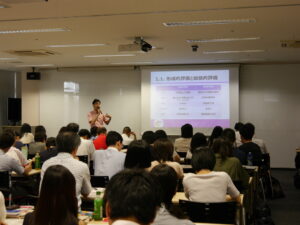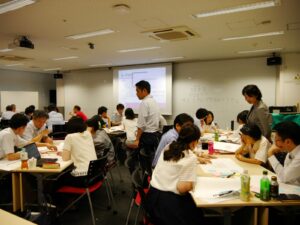2017年08月26日
[Report] “Interactive Teaching” Big Real Session: Part 2 “Becoming a Rubric Master”
We held the event “Interactive Teaching” Big Real Session: Part 2 “Becoming a Rubric Master” on Sunday, August 20th. Here is a brief report and a preview of our next event. Same as last time, please wait for another report to be published at a later date for more details. Also, the videos of the event will be published on the UTokyo TV website.
1. Topic and Goal
This time, the topic was “Rubric,” one of the representative evaluation methods. The goal was to “Be able to create and utilize rubrics that deepen student learning.” There were 80 participants in total, which reached capacity.
2. Summary
The event was conducted in a flipped-classroom manner, and participants worked on pre-class assignments beforehand. They first reviewed what they had learned in the preparation and then examined the general significance and tips (basics) of rubrics and deepened their thoughts in their own contexts.
All participants were asked to watch the videos for WEEK 6 of “Interactive Teaching” and read Chapter 6 of the book “Interactive Teaching” (Kawai Publishing, 2017).
(2) Sessions
[1] Introduction (10:00–10:15)
Participants listened to the explanation of the goals, structure, and rules of the program before introducing themselves to others.
Participants reviewed and organized what they had learned in the preparation through group activities and got ready for Session 2 and onward. They examined the significance of evaluation and points they should be careful of.
Participants examined general significance and tips for creating and utilizing rubrics by improving a sample rubric in groups.
Based on the significance and tips found in Session 2, participants examined how to create and utilize rubrics in their own contexts. They chose one of the following three sessions based on their experience and attributes:
Those who have created and utilized rubrics before gathered in Session A. They first improved the rubrics they brought through a group discussion. Then, they shared their questions on creating/utilizing rubrics and organized Q&As on a poster.
Those who have created rubrics but never have utilized one before or those who have never created rubrics before gathered in Session B. They first created a rubric to evaluate presentations in groups and actually used it to evaluate a presentation (video). Then, they created rubrics for their own classes as much as possible and shared ideas in groups to improve them.
Teachers of elementary school, junior high school, and senior high school gathered in Session C. They first checked the present state of the use of rubrics at senior high school and evaluated a presentation given by senior high school students (video) by using a sample rubric. Then, they improved or newly created their own rubrics and shared ideas in groups to improve them.
Participants organized what they learned, what kind of questions they had, and what they wanted to bring back to their own work through group activities and Q&A sessions.
3. Participants’ Reactions
Eighty participants came from various universities, senior/junior high schools, elementary schools, and companies. According to the five-point scale question asking the degree of satisfaction (valid responses: 73), 67 percent of the respondents were “extremely satisfied” (the highest rating) and 32 percent were “very satisfied” (the second highest rating). We are relieved to know that the event was appreciated to a certain extent, continuously from Part 1 held in February 2017, and are eager to further improve our events to satisfy future participants by examining the points we need to improve as indicated in the feedback.
4. Preview of the Next Program
We are planning to hold the next event in February 2018. Details are to be announced. We look forward to your participation.
Nagafumi Nakamura
(Project Researcher in charge of “Interactive Teaching” / Main Moderator of this event)







